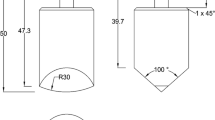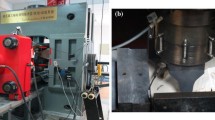Summary
Analogy Between Indentation and Blasting Tests on Brittle Rocks
This paper presents a common mechanism of breaking quasi-brittle rocks either by drilling and blasting or by indentation. Only minor modifications, to account for the prevailing boundary conditions pertaining to either one of these cutting processes, are required.
Rock breakage by drilling and blasting or by indentation is based on the formation of a heterogeneous stress field due to the application of concentrated loads either by the indentor or by the detonation of the explosives. Rock behavior varies according to the stress level generated into the material. In the high stress zone it is plastic or pseudoplastic. In low stress region, failure is of the brittle extension type.
In indentation the formation of a confined plastic zone is essential before chipping. However, for blasting plasticity is not necessary to occur prior to chipping because the high pressure gases that are generated from the explosion are usually quite sufficient — under suitable conditions — to create failure by extension cracking.
Energy consumed in these rock cutting processes is a function of the relative amount of fines produced and their size distribution (or degree of fineness). Further improvements in rock breakage efficiency can be achieved by the proper choice of the important parameters for the specific techniques.
The above analogy can be extended to other well known rock testing and breakage techniques.
Zusammenfassung
Analogie zwischen Eindruck- und Sprengversuchen bei sprödem Gestein
Dieser Bericht befaßt sich mit einem verbreiteten Verfahren zum Brechen von quasi-sprödem Gestein durch Bohren und Sprengen oder durch Eindrücken einer Spitze. Es sind nur geringe Veränderungen nötig, um die wichtigsten Randbedingungen des jeweiligen Bruchverfahrens zu berücksichtigen.
Das Brechen von Fels durch Bohren und Sprengen oder durch Eindruckbeanspruchung beruht auf der Erzeugung eines inhomogenen Spannungsfeldes durch Aufbringung konzentrierter Lasten mittels einer Eindruckspitze oder einer Sprengung. Das Verhalten des Gesteins wird von der Spannungsintensität bestimmt. In Bereichen hoher Spannung ist es plastisch oder pseudoplastisch. In Zonen niedriger Spannung erhält man Dehnungssprödbrüche. Bei der Eindruckbeanspruchung ist die Ausbildung eines begrenzten plastischen Bereichs vor der Bruchauslösung ausschlaggebend. Dagegen ist für Sprengung plastisches Verhalten nicht notwendig, da die bei der Explosion entstandenen Gase unter hohem Druck bei vergleichbaren Voraussetzungen gewöhnlich völlig ausreichen, Zerstörung durch Dehnungsbruch herbeizuführen.
Die für solche Felsbruchverfahren benötigte Energie ist eine Funktion des gewünschten relativen Feingutanteils und dessen Größenverteilung (oder Feinheitsgrad). Die Effektivität von Felsbruchverfahren kann durch richtige Wahl der wichtigen Parameter für die jeweilige Technik gesteigert werden.
Die oben beschriebene Analogie kann auf andere bekannte Test- und Bruchverfahren übertragen werden.
Résumé
Analogie entre poinçonnement et foudroyage des roches fragiles
Cet article traite du mécanisme de rupture observé lors du poinçonnement et du foudroyage de roches du type fragile. Des modifications d'importance secondaire sont à apporter à ce mécanisme pour tenir compte des conditions aux limites propre à chacun de ce deux éssais.
La rupture des roches dans des éssais est due à l'existence d'un champ de contraintes hétérogène résultant du poinçonnement or de la détonation des explosifs. Le comportement rhéologique des roches varie selon l'intensité des contraintes. A la zone comprimée, elle est du type plastique ou pseudoplastique. Par contre, dans la zone tendue, la rupture est du type fragile par extension.
Dans la poinçonnement, la formation de la plasticité confinée sous le poinçon précède l'écaillage. Alors qu'en foudroyage la mise en plasticité autour du trou n'est, à priori, pas nécessaire, la forte préssion du gaz après la détonation pourrait — sour certains conditions — suffire pour rompre la roche autour de la charge d'explosif.
La dépense énergétique dans le phénomène de rupture dépend de la taille des fines et de leur pourcentage dans les produits de rupture. Le choix approprié des paramètres importants du processus de coup résulte en une amélioration du son rendement.
Enfin, l'analogie décrite ici pourrait être étendue à certains techniques d'éssai et de coupe de roches fragiles caractérisés par un champ de contraintes hétérogène.
Similar content being viewed by others
References
El Adawy, S. A.: Study of Some Aspects of Rock Blasting. M. Sc. Dissertation, Cairo University, Faculty of Engineering, 1976.
Khalaf, F.: Contribution à l'étude du comportement des roches fragiles. Thesis, Faculty of Science, Grenoble University, 1970.
Porter, D. D., Fairhurst, C.: Study of Crack Propagation Produced by the Sustained Borehole Pressure in Blasting. Dynamic Rock Mech. 12th Symp. on Rock Mech. Edited by Clark, G. B., SME, 1971.
Reichmuth, D. R.: Correlation of Force-Displacement Data with Physical Rock Properties for Percussion Drilling System. Rock Mechanics (Ed. Fairhurst), Pergamon Press, pp. 33–57, 1963.
Vutukuri, V. S., Bahandari, S.: Some Aspects of Open Pit Blasts. National Symposium on Rock Fragmentation. Australian Geomechanics Society, Adelaide, 1973, pp. 55–61.
Gnirk, P. F., Pfleider, E. P.: On the Correlation Between Explosive Crater Formation and Rock Properties. Status of Practical Rock Mechanics, 9th Symposium on Rock Mechanics, Editors Grosvenor and Pauling. Publication of AIME, 1973.
Dayre, M.: Etude expérimentale de quelques propriétés mécaniques des roches. Thesis, Grenoble University, 1963.
Dayre, M., Khalaf, F.: Remarques sur le choix de la résistance à la compression simple comme critère de forabilité. Journées d'études sur les procédés modernes de construction des tunnels. Lyon (France). 14–15 Oct. 1971.
Sirieys, P. M.: Contribution à l'étude des lois de comportement des structures rocheuses. Dr. ès Sc. Thesis, University of Grenoble (France), 1965.
Julien, A.: Contribution à l'étude du comportement des roches dans les essais à champ de contraintes hétérogènes. Application à l'étude de l'écrasement dans un concasseur à machoirs. Thesis, University of Grenoble (France), 1973.
El Adawy, S. A., El Wageeh, M. A., Abouzeid, A. M.: Effect of Borehole Length and Explosive Charge Weight on Blasting Efficiency. Bulletin of the Faculty of Engineering, Cairo University (Egypt), 1976/1977.
El Borady, A.: Study of Long Wall Method and Its Application in Egyptian Phosphate Mines. M. Sc. Thesis (under preparation). Cairo University, Faculty of Engineering, Mining Dept., 1978.
Khalaf, F.: Contribution a l'étude du poinçonnement des roches fragiles. Dr. ès Sc. Thesis, Grenoble University (France), 1975.
Comming, A. B. (Editor): SME Mining Engineering Handbook. Vol. I, SME-1973, Ch. 11, p. 82.
Barker, J. S.: A Laboratory Investigation of Rock Cutting Using Large Picks. International Journ. of Rock Mech. and Min. Sci. Vol. 1, pp. 519–534, 1964.
George, H. T., Jr.: A Synopsis of Drilling and Blasting. Personal Communication.
Ladanyi, B.: Failure Mechanism of Rock Under a Plate Load. First Int. Congress of Rock Mech., Lisbon, pp. 415–420, 1966.
Lawn, B. R.: Herzian Fracture in Single Crystals with the Diamond Structure. Journ. of Appl. Phys., Vol. 39, pp. 4828–4836, 1968.
Smith, M. B., Holman, C. R., Covlin, R. J.: The Azimuth of Deep, Penetrating Fractures in the Wattenberg Field. Journ. of Pet. Tech. Vol. 30, pp. 185–193, 1978.
Lowrison, G. C.: Crushing and Grinding, The Size Reduction of Solid Materials. London: Butterworths 1974.
Author information
Authors and Affiliations
Additional information
With 9 Figures
Rights and permissions
About this article
Cite this article
Khalaf, F., Abouzeid, AZ.M. Analogy between indentation and blasting tests on brittle rocks. Rock Mechanics 13, 99–117 (1980). https://doi.org/10.1007/BF01238953
Received:
Issue Date:
DOI: https://doi.org/10.1007/BF01238953




